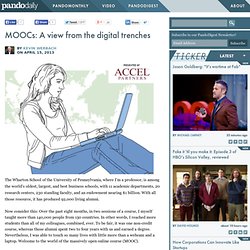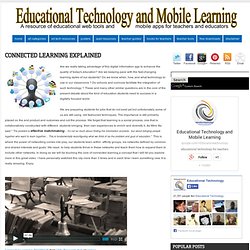

Echo360. MOOCs: A view from the digital trenches. By Kevin Werbach On April 15, 2013 The Wharton School of the University of Pennsylvania, where I’m a professor, is among the world’s oldest, largest, and best business schools, with 11 academic departments, 20 research centers, 230 standing faculty, and an endowment nearing $1 billion.

With all those resource, it has produced 92,000 living alumni. Now consider this: Over the past eight months, in two sessions of a course, I myself taught more than 140,000 people from 150 countries. In other words, I reached more students than all of my colleagues, combined, ever. To be fair, it was one non-credit course, whereas those alumni spent two to four years with us and earned a degree. If you’re interested in higher education, you’ve probably heard spectacular reports and wild predictions about MOOCs. What’s more, I’m still getting emails, tweets, letters and other responses from participants telling me how much they loved the course.
So, what’s the secret to an effective MOOC? Pocket : The MOOC Model: Challenging Traditional Education. Pocket : Massive Open Online Courses, aka MOOCs, Transform Higher Education and Science. Pocket : MOOCs: Learning for All? Educators as Social Networked Learners. This fall, I am getting the opportunity to design and teach a graduate course for Boise State University’s Education Technology Program entitled, Social Networked Learning.

The majority of students in the program are K-12 in-service teachers who are seeking ways to enhance their teaching with integrated and emerging technologies. I am so excited about what students are producing for this course and in terms of meeting this goal that I wanted to share information about the course, a sampling of course activities, and example student work. Course Description This course explores collaborative and emergent pedagogies, tools, and theory related to the use of social networks in learning environments. Participants gain hands-on experience with a variety social networking tools, create their own personal learning networks, and have an opportunity to develop a MOOC-inspired course for their learners. From E-Learning to We-Learning. The corporate training industry is undergoing some major changes.

Over last few months we have been involved in many discussions with organizations about the tremendous needs to build, manage, and formalize their social and collaborative learning programs. This is being driven by many factors: the slowing economy, the "always-connected" nature of the workforce, and the explosion of social software tools and platforms now available. In many ways, this transition is very similar to the last "big thing" to hit corporate training - the "e-learning" era. The word "e-learning" started in 1998 and we went through a radical change in thinking about training over the next 10 years.
I think today's transformation is very similar and we have much we can learn from that history. Educational Technology and Mobile Learning: Connected Learning Explained. Are we really taking advantage of this digital information age to enhance the quality of today's education?

Are we keeping pace with the fast-changing learning styles of our students? Do we know when, how, and what technology to use in our classrooms ? Do schools and curricula facilitate the integration of such technology ? These and many other similar questions are in the core of the present debate about the kind of education students need to success in a digitally focused world. We are preparing students for jobs that do not exist yet but unfortunately some of us are still using old fashioned techniques. Connected Learning: 'ESSENCE' from DML Research Hub on Vimeo. The Essence of Connected Learning. Connected Learning: The Power Of Social Learning Models. DML (a “Digital Media and Learning” project), believes in the “the power of participation.”

And they’ve created a learning model overview to prove it. We recently published our Inside-Out Learning model, an attempt to return the learning to the families, organizations, and communities authentic to the learner. DML’s model is similar in philosophy, underscoring the role of interdependence. Called Connected Learning, the model is a response to changing face of culture as it relates to social and digital media. As technology evolves at breakneck speed, models that account for this kind of change are few and far between. Connected Learning “is an answer to three key shifts as society evolves from the industrial age of the 20th century and its one-size-fits-all factory approach to educating youth to a 21st century networked society.” 1) A shift from education to learning. 2) A shift from consumption of information to participatory learning. 3) A shift from institutions to networks.
Pocket : How was it? The UK’s first Coursera Moocs assessed. Pocket : Rise of the MOOCs. Mooc. MOOC Articles. Connectivism. Networked Society. MOOCs.